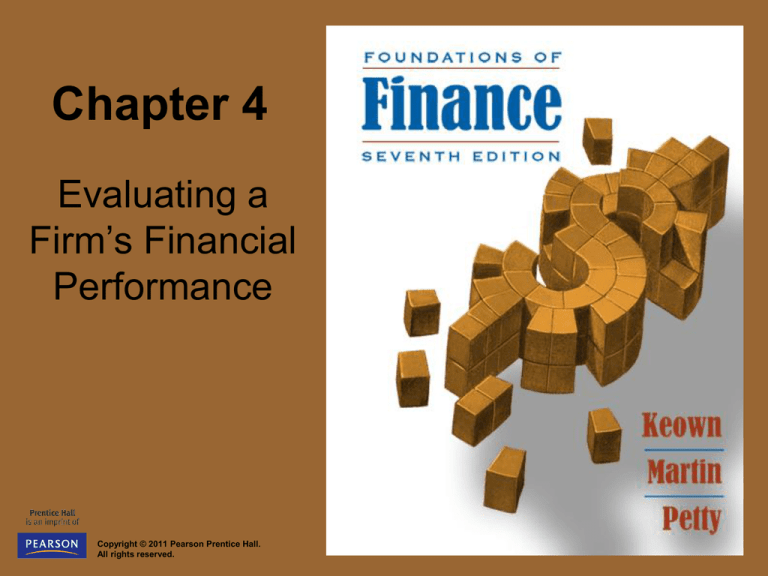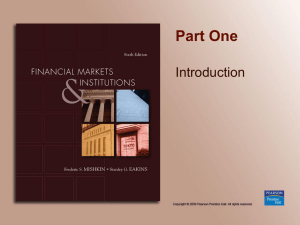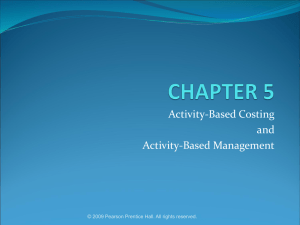
Chapter 4
Evaluating a
Firm’s Financial
Performance
Copyright © 2011 Pearson Prentice Hall.
All rights reserved.
Complementary
© 2011 Pearson Prentice Hall. All rights reserved.
4-1
Learning Objectives
Explain the purpose and importance of
financial analysis.
Calculate and use a comprehensive set of
measurements to evaluate a company’s
performance.
Describe the limitations of financial ratio
analysis.
© 2011 Pearson Prentice Hall. All rights reserved.
4-2
Slide Contents
Principles used in this Chapter
1. The purpose of Financial Analysis
2. Measuring Key Financial Relationships:
Five Key Questions
3. The Limitations of Financial Ratio Analysis
© 2011 Pearson Prentice Hall. All rights reserved.
4-3
Principles Applied
in this Chapter
Principle 5:
Conflicts of interest cause agency problems
Principle 4:
Markets are generally right
Principle 3:
Risk requires a reward
© 2011 Pearson Prentice Hall. All rights reserved.
4-4
1. The Purpose of
Financial Analysis
Financial Analysis using Ratios
A popular way to analyze the financial statements is
by computing ratios. A ratio is a relationship between
two numbers, e.g. If ratio of A: B = 30:10 ==> A is 3
times B.
A ratio by itself may have no meaning. Hence, a
given ratio is compared to:
(a) ratios from previous years
(b) ratios of other firms and/or leaders in the same industry
© 2011 Pearson Prentice Hall. All rights reserved.
4-5
Uses of Financial Ratios:
Within the Firm
Identify deficiencies in a firm’s performance
and take corrective action.
Evaluate employee performance and
determine incentive compensation.
Compare the financial performance of
different divisions within the firm.
© 2011 Pearson Prentice Hall. All rights reserved.
4-6
Uses of Financial Ratios:
Within the Firm
Prepare, at both firm and division levels,
financial projections.
Understand the financial performance of the
firm’s competitors.
Evaluate the financial condition of a major
supplier.
© 2011 Pearson Prentice Hall. All rights reserved.
4-7
Uses of Financial Ratios:
Outside the Firm
Financial ratios are used by:
Lenders in deciding whether or not to make a loan to
a company.
Credit-rating agencies in determining a firm’s credit
worthiness.
Investors (shareholders and bondholders) in deciding
whether or not to invest in a company.
Major suppliers in deciding to whether or not to grant
credit terms to a company.
© 2011 Pearson Prentice Hall. All rights reserved.
4-8
2. Measuring Key Financial
Relationships: Five Key Questions
1. How liquid is the firm?
2. Is management generating adequate
operating profits on the firm’s assets?
3. How is the firm financing its assets?
4. Is management providing a good return on
the capital provided by the shareholders?
5. Is the management team creating
shareholder value?
© 2011 Pearson Prentice Hall. All rights reserved.
4-9
How Liquid Is the Firm?
A liquid asset is one that can be
converted quickly and routinely into
cash at the current market price.
Liquidity measures the firm’s ability to
pay its bills on time. It indicates the
ease with which non-cash assets can
be converted to cash to meet the
financial obligations.
© 2011 Pearson Prentice Hall. All rights reserved.
4-10
How Liquid Is the Firm?
Liquidity is measured by two
approaches:
Comparing the firm’s current assets and
current liabilities
Examining the firm’s ability to convert
accounts receivables and inventory into
cash on a timely basis
© 2011 Pearson Prentice Hall. All rights reserved.
4-11
Measuring Liquidity:
Perspective 1
Compare a firm’s current assets with
current liabilities
Current Ratio
Acid Test or Quick Ratio
© 2011 Pearson Prentice Hall. All rights reserved.
4-12
Table 4-2
© 2011 Pearson Prentice Hall. All rights reserved.
4-13
Current Ratio
Current ratio compares a firm’s current assets to its
current liabilities.
Formula:
Current ratio = Current assets/Current liabilities
Davies Example:
= $143M / $64M
= 2.23
© 2011 Pearson Prentice Hall. All rights reserved.
4-14
Interpretation (Current ratio)
Davies has $2.23 in current assets for
every $1 in current liabilities.
The average is higher than the peer
group’s ratio of 1.80.
© 2011 Pearson Prentice Hall. All rights reserved.
4-15
Acid Test or Quick Ratio
Quick ratio compares cash and current assets (minus
inventory) that can be converted into cash during the year
with the liabilities that should be paid within the year.
What is the rationale for excluding inventories?
Formula:
Quick Ratio = Cash and accounts receivable/Current liabilities
Davies Example
= ($20M + $36M) / $64M
= 0.88
© 2011 Pearson Prentice Hall. All rights reserved.
4-16
Interpretation (Quick Ratio)
Davis has 88 cents in quick assets for every
$1 in current liabilities.
Davis is less liquid compared to its peers that
have 94 cents for every $1
in current liabilities.
Which ratio (Current or Quick ratio) is a more
stringent test of a firm’s liquidity?
© 2011 Pearson Prentice Hall. All rights reserved.
4-17
Table 4-1
© 2011 Pearson Prentice Hall. All rights reserved.
4-18
Davis vs. Peer Group:
Question #1 Summary
Ratio
Current Ratio
Quick Ratio
Avg. Collection
Period
Inventory Turnover
(days in inventory)
© 2011 Pearson Prentice Hall. All rights reserved.
Davies Inc.
2.23
Peers
1.80
.88
.94
21.95
25
5.48 (67)
7 (52)
4-19
Are the Firms’ Managers
Generating Adequate Operating
Profits on the Company’s Assets?
This question focuses on the profitability of
the assets in which the firm has invested. We
will consider the following ratios to answer
the question:
Operating Return on Assets
Operating Profit Margin
Total Asset Turnover
Fixed Asset Turnover
© 2011 Pearson Prentice Hall. All rights reserved.
4-20
Managing operations:
Operating Profit Margin (OPM)
OPM examines how effective the company is in
managing its cost of goods sold and operating expenses
that determine the operating profit.
Formula: OPM = Operating profit/Sales
Davies Example
= $75M / $600M = .125 or 12.5%
Davies managers are not as good as peers in managing
the cost of goods sold and operating expenses, as the
average for peers is higher at 15.5%
© 2011 Pearson Prentice Hall. All rights reserved.
4-21
2.3 How Is the Firm
Financing Its Assets?
Here we examine the question: Does the firm
finance its assets by debt or equity or both?
We use the following two ratios to answer the
question:
Debt Ratio
© 2011 Pearson Prentice Hall. All rights reserved.
4-22
Debt Ratio
This ratio indicates the percentage of the firm’s assets
that are financed by debt (implying that the balance is
financed by equity).
Formula: Debt Ratio = Total debt/Total assets
Davies Example
= $235M / $438M = .54 or 54%
Davies finances 54% of firm’s assets by debt and 46%
by equity. This ratio is higher than peer average of 35%.
© 2011 Pearson Prentice Hall. All rights reserved.
4-23
Davies vs. Peer Group:
Question #3 Summary
Ratio
Debt Ratio
Times Interest
Earned
© 2011 Pearson Prentice Hall. All rights reserved.
Davies Inc.
Peers
54%
35%
5X
7X
4-24
Are the Firm’s Managers Providing
a Good Return on the Capital Provided
by the Shareholders?
This is analyzed by computing the firm’s
accounting return on common stockholder’s
investment or return on equity (ROE).
Formula: ROE = Net income/Common
equity
Common equity includes both common
stock and retained earnings.
© 2011 Pearson Prentice Hall. All rights reserved.
4-25
ROE
Davies Example
ROE = $42M / $203M
= .207 or 20.7%
Owners of Davies are receiving a higher return
(20.7%) compared to the peer group (18%).
One of the reasons for higher ROE for Davies is the
higher debt used by Davies. Higher debt translates to
higher ROE under favorable business conditions.
© 2011 Pearson Prentice Hall. All rights reserved.
4-26
Figure 4-4
© 2011 Pearson Prentice Hall. All rights reserved.
4-27
Question #4 Summary:
Davies vs. Peer Group
Ratio
Return on Equity
© 2011 Pearson Prentice Hall. All rights reserved.
Davies Inc.
12.9%
Peers
12.0%
4-28
2.5 Are the Firm’s Managers
Creating Shareholder Value?
We can use this approach to answer this
question:
Market value ratios (P/E)
This ratio indicates what investors think of
management’s past performance and future
prospects.
© 2011 Pearson Prentice Hall. All rights reserved.
4-29
Price/Earnings Ratio
Measures how much investors are willing to pay for
$1 of reported earnings.
Formula:
PE = Price per share/Earnings per share
Davies Example
= $32.00 / $2.10 = 15.24X
Investors are willing pay less for Davies for every
dollar of earnings compared to peers ($15.24 for
Davies versus $19 for peers).
© 2011 Pearson Prentice Hall. All rights reserved.
4-30
Price/Book Ratio
Compares the market value of a share of stock to the book
value per share of the reported equity on the balance
sheet.
Formula:
= Price per share/Equity book value per share
Davies Example
= $32.00 / $10.15 = 3.15X
A ratio greater than 1 indicates that the shares are more
valuable than what the shareholders originally paid.
However, the ratio is lower than the S&P average of 3.70.
© 2011 Pearson Prentice Hall. All rights reserved.
4-31
Question #5 Summary:
Davies vs. S&P/Peers
Ratio
Price/Earnings
Ratio
Price/Book Ratio
© 2011 Pearson Prentice Hall. All rights reserved.
Davies Inc.
15.24X
Peers
19X (Peers)
3.15X
3.7X
(S&P 500)
4-32
3. The Limitations of
Financial Ratio Analysis
It is sometimes difficult to identify industry categories
or comparable peers.
The published peer group or industry averages are
only approximations.
Industry averages may not provide a desirable target
ratio.
Accounting practices differ widely among firms.
A high or low ratio does not automatically lead to a
specific conclusion.
Seasons may bias the numbers in the financial
statements.
© 2011 Pearson Prentice Hall. All rights reserved.
4-33
Table 4-1
© 2011 Pearson Prentice Hall. All rights reserved.
4-34
Table 4-2
© 2011 Pearson Prentice Hall. All rights reserved.
4-35
Table 4-3
© 2011 Pearson Prentice Hall. All rights reserved.
4-36
Table 4-3 (cont.)
© 2011 Pearson Prentice Hall. All rights reserved.
4-37
Table 4-3 (cont.)
© 2011 Pearson Prentice Hall. All rights reserved.
4-38
Key Terms
Accounts receivable
turnover ratio
Acid-test ratio
Asset efficiency
Current ratio
Debt ratio
Financial ratios
© 2011 Pearson Prentice Hall. All rights reserved.
Liquidity
Operating profit margin
Operating return on
assets
Price/book ratio
Price/earnings ratio
Return on equity
4-39






